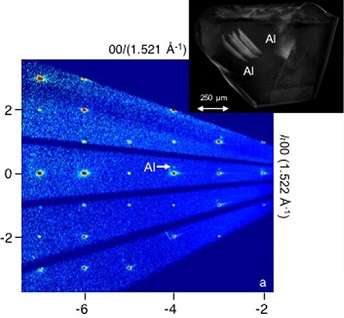Defects, electrons, and a long-standing controversy

Faster, more energy-efficient electronics could be created with topological insulators, which carry an electrical charge on just the surface, while the interior acts as an insulator. Scientists are delving into how the material's structure and chemistry correlate with its unusual electronic properties. By carefully controlling and monitoring chemical changes in the topological insulator bulk samarium hexaboride (SmB6), scientists reconciled a long-standing controversy on the diverse results on its low-temperature electrical properties and established a systematic relationship between the bulk chemistry and surface topological properties. Using chemical structures and electrical properties measured under extremely cold conditions, the team showed that electron dopants enhance the topological behavior of SmB 6 while aluminum defects and samarium vacancies suppress it.
Understanding of the mechanism paves a way to control the properties of topological insulators, as they hold great promise for next-generation energy-efficient electronics and a platform for scalable quantum computers, if their exotic surface electronic states can be selectively harnessed.
Departures from regularity—defects and imperfections—in materials are the key to their novel properties, and control over the type, number, and distribution of defects is essential to design materials for future technologies. For over four decades, samarium hexaboride (SmB6) has been extensively investigated for its range of electronic properties. Recently, it serves as a paradigm material for topological insulators—materials with charge on their surfaces that are protected against disorder within the bulk. A major and controversial issue has been the large variation in its resistivity data at low temperatures. Addressing the long-standing controversy on this important material requires high-quality single crystal samples with controlled defects within the bulk, coupled with advanced characterization of their structure and physical properties.
Applying two well-known crystal growth techniques—floating zone and aluminum flux synthesis—scientists from The Johns Hopkins University examined a series of high-quality SmB6 single crystals with aluminum impurities (defects) as well as systematically controlled levels of electrons by replacing boron with carbon and holes by creating samarium atom vacancies. Chemical structures derived from high-resolution neutron and X-ray diffraction and electrical properties measured at cryogenic conditions revealed a correlation between the defects and electrical properties; electron dopants enhance the topological behavior while aluminum defects and samarium vacancies suppress it.
This finding reconciles a long-standing controversy of disparate reports on the behavior of this fascinating class of materials and demonstrates that it is possible to chemically control exotic topological surface states by tuning the bulk chemistry. The understanding and control of these materials is of great interest for the creation of viable quantum computers and more energy-efficient electronics.
More information: W. A. Phelan et al. Correlation between Bulk Thermodynamic Measurements and the Low-Temperature-Resistance Plateau in, Physical Review X (2014). DOI: 10.1103/PhysRevX.4.031012
Journal information: Physical Review X
Provided by US Department of Energy




















